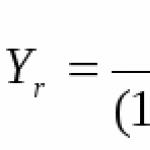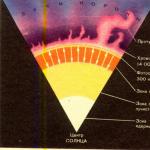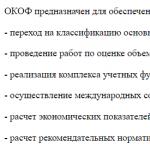The procedure for performing namaz in the four madhhabs (theological and legal schools) of Islam has some minor differences, through which the entire palette of the prophetic heritage is interpreted, revealed and mutually enriched. Considering that on the territory of the Russian Federation and the CIS, the madhhab of Imam Nu'man ibn Sabit Abu Hanifa, as well as the madhhab of Imam Muhammad ibn Idris al-Shafi'i, are most widely spread, we will analyze in detail only the features of the two schools mentioned.
In ritual practice, it is advisable for a Muslim to follow any one madhhab, but in a difficult situation, as an exception, one can act according to the canons of any other Sunni madhhab.
“Perform the obligatory prayer and pay zakat [obligatory charity]. Hold on to God [ask for help only from Him and rely on Him, strengthen yourself through worshiping Him and doing good deeds to Him]. He is your Patron..." (see).
Attention! Read all articles on prayer and issues related to it in a special section on our website.
“Truly, it is prescribed for believers to perform prayer-namaz at a strictly defined time!” (cm. ).
In addition to these verses, let us recall that the hadith, which lists the five pillars of religious practice, also mentions daily prayer five times a day.
To perform prayer the following conditions must be met:
1. The person must be a Muslim;
2. He must be an adult (children must begin to be taught to pray from the age of seven to ten);
3. He must be of sound mind. People with mental disabilities are completely exempt from religious practice;
6. Clothing and place of prayer should be;
8. Turn your face towards Mecca, where the shrine of Abrahamic Monotheism is located - the Kaaba;
9. There must be an intention to pray (in any language).
Order of performing morning prayer (Fajr)
Time performing morning prayer - from the moment of dawn until the beginning of sunrise.
Morning prayer consists of two rak'ahs of sunnah and two rak'ahs of fard.
Two rak'ahs of sunnah
At the end of the azan, both the reader and the one who heard it say “salavat” and, raising their hands to chest level, turn to the Almighty with a prayer traditionally recited after the azan:
Transliteration:
“Allaahumma, Rabba haazihi dda’wati ttaammati wa ssalyayatil-kaaima. Eeti mukhammadanil-vasilyata val-fadyilya, wab'ashu makaaman mahmuudan elyazii va'adtakh, warzuknaa shafa'atahu yavmal-kyayame. Innakya laya tuhliful-mii’aad.”
للَّهُمَّ رَبَّ هَذِهِ الدَّعْوَةِ التَّامَّةِ وَ الصَّلاَةِ الْقَائِمَةِ
آتِ مُحَمَّدًا الْوَسيِلَةَ وَ الْفَضيِلَةَ وَ ابْعَثْهُ مَقَامًا مَحْموُدًا الَّذِي وَعَدْتَهُ ،
وَ ارْزُقْنَا شَفَاعَتَهُ يَوْمَ الْقِيَامَةِ ، إِنَّكَ لاَ تُخْلِفُ الْمِيعَادَ .
Translation:
“O Allah, Lord of this perfect call and beginning prayer! Give Prophet Muhammad “al-wasiyla” and dignity. Give him the high position promised. And help us to take advantage of his intercession on the Day of Judgment. Verily, You do not break your promise!”
Also, after reading the azan, announcing the onset of morning prayer, it is advisable to say the following du‘a:
Transliteration:
“Allaahumma haaze ikbaalyu nahaarikya wa idbaaru laylikya wa asvaatu du’aatik, fagfirlii.”
اَللَّهُمَّ هَذَا إِقْبَالُ نَهَارِكَ وَ إِدْباَرُ لَيْلِكَ
وَ أَصْوَاتُ دُعَاتِكَ فَاغْفِرْ لِي .
Translation:
“O Almighty! This is the coming of Your day, the end of Your night and the voices of those calling to You. I'm sorry!"
Step 2. Niyat
(intention): “I intend to perform two rak’ahs of the sunnah of morning prayer, doing it sincerely for the sake of the Almighty.”
Then men, raising their hands to ear level so that the thumbs touch the lobes, and women - to shoulder level, pronounce “takbir”: “Allahu akbar” (“Allah is great”). It is advisable for men to separate their fingers, and for women to close them. After this, men place their hands on their stomachs just below the navel, placing their right hand on top of their left, wrapping the little finger and thumb of their right hand around the wrist of their left. Women lower their hands to their chests, placing their right hand on the left wrist.
The gaze of the worshiper is directed to the place where he will lower his face during prostration.
Step 3
Then Surah al-Ikhlas is read:
Transliteration:
“Kul huwa laahu ahad. Allahu ssomad. Lam yalid wa lam yulyad. Wa lam yakul-lyahu kufuvan ahad.”
قُلْ هُوَ اللَّهُ أَحَدٌ . اَللَّهُ الصَّمَدُ . لَمْ يَلِدْ وَ لَمْ يوُلَدْ . وَ لَمْ يَكُنْ لَهُ كُفُوًا أَحَدٌ .
Translation:
“Say: “He, Allah, is One. God is Eternal. [Only He is the one in whom everyone will need to infinity.] He did not give birth and was not born. And no one can equal Him."
Step 4
The person praying with the words “Allahu Akbar” makes a bow from the waist. At the same time, he places his hands on his knees, palms down. Bend over, straightens his back, holds his head at the level of his back, looking at the soles of his feet. Having accepted this position, the worshiper says:
Transliteration:
"Subhaana rabbiyal-'azim"(3 times).
سُبْحَانَ رَبِّيَ الْعَظِيمِ
Translation:
"Praise be to my Great Lord."
Step 5
The worshiper returns to his previous position and, rising, says:
Transliteration:
"Sami'a laahu li men hamidekh."
سَمِعَ اللَّهُ لِمَنْ حَمِدَهُ
Translation:
« The Almighty hears the one who praises Him».
Straightening up, he says:
Transliteration:
« Rabbanaa lakal-hamd».
رَبَّناَ لَكَ الْحَمْدُ
Translation:
« Our Lord, praise only to You».
It is possible (sunnah) to also add the following: “ Mil'as-samaavaati wa mil'al-ard, wa mil'a maa shi'te min shein ba'd».
مِلْءَ السَّمَاوَاتِ وَ مِلْءَ اْلأَرْضِ وَ مِلْءَ مَا شِئْتَ مِنْ شَيْءٍ بَعْدُ
Translation:
« [Our Lord, praise be to You alone] which fills the heavens and the earth and whatever You desire».
Step 6
The person praying with the words “Allahu Akbar” lowers himself to bow to the ground. Most Islamic scholars (jumhur) said that from the point of view of the Sunnah, the most correct way to bow to the ground is to lower your knees first, then your hands, and then your face, placing it between your hands and touching your nose and forehead to the ground (rug).
In this case, the tips of the toes should not leave the ground and be directed towards the qibla. Eyes must be open. Women press their chests to their knees, and their elbows to their torso, while it is advisable for them to close their knees and feet.
After the worshiper has accepted this position, he says:
Transliteration:
« Subhaana rabbiyal-a'lyaya" (3 times).
سُبْحَانَ رَبِّيَ الأَعْلىَ
Translation:
« Praise be to my Lord, Who is above all».
Step 7
With the words “Allahu Akbar,” the worshiper raises his head, then his hands, and, straightening up, sits on his left leg, placing his hands on his hips so that his fingertips touch his knees. The worshiper remains in this position for some time. It should be noted that, according to the Hanafis, in all sitting positions when performing prayer, women should sit with their thighs joined and both feet pointing out to the right. But this is not fundamental.
Then again, with the words “Allahu Akbar,” the worshiper lowers himself to make a second prostration and repeats what was said during the first.
Step 8
Raising first his head, then his hands, and then his knees, the worshiper stands up, saying “Allahu Akbar,” and takes his original position.
This ends the first rakyaat and the second begins.
In the second rakyaat, “as-Sana” and “a’uzu bil-lyahi minash-shaytoni rrajim” are not read. The worshiper begins immediately with “bismil-lahi rrahmani rrahim” and does everything in the same way as in the first rakyaat, until the second bow to the ground.
Step 9
After the worshiper rises from the second prostration, he again sits on his left foot and reads “tashahhud.”
Hanafis (placing their hands loosely on their hips without closing their fingers):
Transliteration:
« At-tahiyayatu lil-lyahi vas-salavaatu wat-toyibaat,
As-salayamu ‘alaikya ayukhan-nabiyu wa rahmatul-laahi wa barakayatukh,
Ashkhadu allaya ilyayahe illya llaahu wa ashkhadu anna muhammadan ‘abduhu wa rasuulyukh.”
اَلتَّحِيَّاتُ لِلَّهِ وَ الصَّلَوَاتُ وَ الطَّيِّباَتُ
اَلسَّلاَمُ عَلَيْكَ أَيـُّهَا النَّبِيُّ وَ رَحْمَةُ اللَّهِ وَ بَرَكَاتُهُ
اَلسَّلاَمُ عَلَيْناَ وَ عَلىَ عِبَادِ اللَّهِ الصَّالِحِينَ
أَشْهَدُ أَنْ لاَ إِلَهَ إِلاَّ اللَّهُ وَ أَشْهَدُ أَنَّ مُحَمَّدًا عَبْدُهُ وَ رَسُولُهُTranslation:
« Greetings, prayers and all good deeds belong only to the Almighty.
Peace be upon you, O Prophet, the mercy of God and His blessing.
Peace be upon us and the pious servants of the Almighty.
I testify that there is no god but Allah, and I testify that Muhammad is His servant and Messenger.”
When pronouncing the words “la ilahe”, it is advisable to raise the index finger of the right hand up, and when saying “illa llaahu”, lower it.
Shafiites (placing the left hand freely, without separating the fingers, and clenching the right hand into a fist and releasing the thumb and forefinger; while the thumb is in a bent position adjacent to the hand):
Transliteration:
« At-tahiyayatul-mubaarakayatus-salavaatu ttoyibaatu lil-layah,
As-salayamu ‘alaikya ayukhan-nabiyu wa rahmatul-laahi wa barakayatuh,
As-salayamu ‘alyainaa wa ‘alaya ‘ibaadil-lyahi ssaalihiin,
Ashhadu allaya ilyayahe illya llaahu wa ashhadu anna muhammadan rasuulul-laah.”
اَلتَّحِيَّاتُ الْمُبَارَكَاتُ الصَّلَوَاتُ الطَّـيِّـبَاتُ لِلَّهِ ،
اَلسَّلاَمُ عَلَيْكَ أَيـُّهَا النَّبِيُّ وَ رَحْمَةُ اللَّهِ وَ بَرَكَاتـُهُ ،
اَلسَّلاَمُ عَلَيْـنَا وَ عَلىَ عِبَادِ اللَّهِ الصَّالِحِينَ ،
أَشْهَدُ أَنْ لاَ إِلَهَ إِلاَّ اللَّهُ وَ أَشْهَدُ أَنَّ مُحَمَّدًا رَسُولُ اللَّهِ .While pronouncing the words “illa-laahu,” the index finger of the right hand is raised up without additional movements (while the gaze of the praying person can be turned to this finger) and lowered.
Step 10
After reading “tashahhud”, the worshiper, without changing his position, says “salavat”:
Transliteration:
« Allahumma sally ‘alaya sayidinaa muhammadin wa ‘alaaya eeli sayidinaa muhammad,
Kyama sallayte ‘alaya sayidinaa ibraakhim va ‘alaya eeli sayidinaa ibraakhim,
Wa baarik ‘alaya sayidinaa Muhammadin wa ‘alaya eeli sayidinaa Muhammad,
Kamaa baarakte ‘alaya sayidinaa ibraakhima va ‘alaiya eeli sayidinaa ibraakhima fil-‘aalamiin, innekya hamiidun majiid» .
اَللَّهُمَّ صَلِّ عَلىَ سَيِّدِناَ مُحَمَّدٍ وَ عَلىَ آلِ سَيِّدِناَ مُحَمَّدٍ
كَماَ صَلَّيْتَ عَلىَ سَيِّدِناَ إِبْرَاهِيمَ وَ عَلىَ آلِ سَيِّدِناَ إِبْرَاهِيمَ
وَ باَرِكْ عَلىَ سَيِّدِناَ مُحَمَّدٍ وَ عَلىَ آلِ سَيِّدِناَ مُحَمَّدٍ
كَماَ باَرَكْتَ عَلىَ سَيِّدِناَ إِبْرَاهِيمَ وَ عَلىَ آلِ سَيِّدِناَ إِبْرَاهِيمَ فِي الْعاَلَمِينَ
إِنَّكَ حَمِيدٌ مَجِيدٌTranslation:
« O Allah! Bless Muhammad and his family, as You blessed Ibrahim (Abraham) and his family.
And send down blessings on Muhammad and his family, just as You sent down blessings on Ibrahim (Abraham) and his family in all the worlds.
Verily, You are the Praised One, the Glorified One.”
Step 11
After reading the salavat, it is advisable to turn to the Lord with a prayer (du'a). Theologians of the Hanafi madhhab claim that only that form of prayer that is mentioned in the Holy Quran or in the Sunnah of the Prophet Muhammad (may the Lord bless him and greet him) can be used as a du‘a. Another part of Islamic theologians allows the use of any form of du'a. At the same time, the opinion of scientists is unanimous that the text of the du'a used in prayer should only be in Arabic. This prayer-du'a is read without raising the hands.
Let us list the possible forms of supplication (du'a):
Transliteration:
« Rabbanaa eetina fid-dunyaya hasanatan wa fil-aakhyrati hasanatan wa kynaa ‘azaaban-naar».
رَبَّناَ آتِناَ فِي الدُّنـْياَ حَسَنَةً وَ فِي الأَخِرَةِ حَسَنَةً وَ قِناَ عَذَابَ النَّارِ
Translation:
« Our Lord! Give us good things in this and the next life, protect us from the torments of Hell».
Transliteration:
« Allahumma innii zolyamtu nafsia zulmen kyasiira, va innahu laya yagfiru zzunuube illya ent. Fagfirlii magfiraten min ‘indik, warhamnia, innakya entel-gafuurur-rahiim».
اَللَّهُمَّ إِنيِّ ظَلَمْتُ نـَفْسِي ظُلْمًا كَثِيرًا
وَ إِنـَّهُ لاَ يَغـْفِرُ الذُّنوُبَ إِلاَّ أَنـْتَ
فَاغْـفِرْ لِي مَغـْفِرَةً مِنْ عِنْدِكَ
وَ ارْحَمْنِي إِنـَّكَ أَنـْتَ الْغـَفوُرُ الرَّحِيمُTranslation:
« O Almighty! Verily, I have repeatedly acted unjustly towards myself [by committing sins], and no one forgives sins except You. Forgive me with Your forgiveness! Have mercy on me! Verily, You are the Forgiving, the Merciful».
Transliteration:
« Allahumma innii a'uuzu bikya min 'azaabi jahannam, wa min 'azaabil-kabr, wa min fitnatil-makhyaya wal-mamaat, wa min sharri fitnatil-myasihid-dajaal».
اَللَّهُمَّ إِنيِّ أَعُوذُ بِكَ مِنْ عَذَابِ جَهَنَّمَ
وَ مِنْ عَذَابِ الْقـَبْرِ وَ مِنْ فِتْنَةِ الْمَحْيَا
وَ الْمَمَاتِ وَ مِنْ شَرِّ فِتْنَةِ الْمَسِيحِ الدَّجَّالِ .Translation:
« O Almighty! Truly, I ask You for protection from the torment of Hell, torment in the afterlife, from the temptations of life and death and from the temptation of the Antichrist».
Step 12
After this, the person praying with the words of greeting “as-salayamu ‘alaikum wa rahmatul-laah” (“peace and blessings of Allah be upon you”) turns his head first to the right side, looking at the shoulder, and then, repeating the words of greeting, to the left. This ends the two rak'ahs of the sunnah prayer.
Step 13
1) “Astagfirullaa, astagfirullaa, astagfirullaa.”
أَسْـتَـغـْفِرُ اللَّه أَسْتَغْفِرُ اللَّه أَسْـتَـغـْفِرُ اللَّهَ
Translation:
« Forgive me, Lord. Forgive me, Lord. Forgive me, Lord».
2) Raising his hands to chest level, the worshiper says: “ Allahumma ente ssalyayam va minkya ssalyayam, tabaarakte yaa zal-jalyali wal-ikraam. Allahumma a‘innii ‘ala zikrika wa shukrika wa husni ‘ibaadatik».
اَللَّهُمَّ أَنـْتَ السَّلاَمُ وَ مِنْكَ السَّلاَمُ
تَـبَارَكْتَ ياَ ذَا الْجَـلاَلِ وَ الإِكْرَامِ
اللَّهُمَّ أَعِنيِّ عَلىَ ذِكْرِكَ وَ شُكْرِكَ وَ حُسْنِ عِباَدَتـِكَTranslation:
« O Allah, You are peace and security, and only from You come peace and security. Give us a blessing (that is, accept the prayer we performed). O He Who possesses greatness and generosity, O Allah, help me to remember You worthily, worthily thank You and worship You in the best way».
Then he lowers his hands, running his palms over his face.
It should be noted that during the performance of two rakyaats of the sunnah of morning prayer, all prayer formulas are pronounced silently.
Two rak'ahs fard
Step 1. Iqamat
Step 2. Niyat
Then all the steps described above are performed when explaining the two rakyats of the sunnah.
The exception is that Surah al-Fatiha and the Surah recited after it are recited aloud here. If a person performs prayer alone, he can read it both aloud and silently, but it is better to read it out loud. If he is the imam in prayer, then it is obligatory to read it out loud. The words “a‘uuzu bil-lyahi minash-shaytooni rrajiim. Bismil-lyahi rrahmaani rrahiim” are pronounced silently.
Completion. At the end of the prayer, it is advisable to perform “tasbihat”.
Tasbihat (glorifying the Lord)
The Prophet Muhammad (peace and blessings of Allaah be upon him) said: “Whoever, after prayer, says “subhaanal-laah” 33 times, “al-hamdu lil-layah” 33 times and “Allahu akbar” 33 times, which makes the number 99, equal to the number of names of the Lord, and after that he will add to one hundred, saying: “Laya ilyayahe illya llaahu wahdahu la sariikya lyah, lyahul-mulku wa lyahul-hamdu, yukhyi wa yumiitu wa huva 'alaya kulli shayin kadiir”, he will be forgiven [small] errors, even if their number is equal to the amount of sea foam."
Performing “tasbihat” belongs to the category of desirable actions (sunnah).
Tasbihat sequence
1. Read the verse “al-Kursi”:
Transliteration:
« A'uuzu bil-lyahi minash-shaytooni rrajiim. Bismil-lyahi rrahmaani rrahiim. Allahu laya ilyahya illya huwal-hayyul-kayuum, laya ta'huzuhu sinatuv-valya naum, lyahuu maa fis-samaavaati wa maa fil-ard, men zal-lyazi yashfya'u 'indahu illya bi izkh, ya'lamu maa baina aidihim va maa halfakhum wa laya yuhiituune bi sheyim-min 'ilmihi illya bi maa shaa', wasi'a kursiyuhu ssamaavaati val-ard, wa laya yauuduhu hifzukhumaa wa huval-'aliyul-'azim».
أَعوُذُ بِاللَّهِ مِنَ الشَّـيْطَانِ الرَّجِيمِ . بِسْمِ اللَّهِ الرَّحْمَنِ الرَّحِيمِ .
اَللَّهُ لاَ إِلَهَ إِلاَّ هُوَ الْحَىُّ الْقَيُّومُ لاَ تَـأْخُذُهُ سِنَةٌ وَ لاَ نَوْمٌ لَهُ ماَ فِي السَّماَوَاتِ وَ ماَ فِي الأَرْضِ مَنْ ذَا الَّذِي يَشْفَعُ عِنْدَهُ إِلاَّ بِإِذْنِهِ يَعْلَمُ ماَ بَيْنَ أَيْدِيهِمْ وَ ماَ خَلْفَهُمْ وَ لاَ يُحِيطُونَ بِشَيْءٍ مِنْ عِلْمِهِ إِلاَّ بِماَ شَآءَ وَسِعَ كُرْسِـيُّهُ السَّمَاوَاتِ وَ الأَرْضَ وَ لاَ يَؤُودُهُ حِفْظُهُمَا وَ هُوَ الْعَلِيُّ العَظِيمُ
Translation:
“I seek refuge with Allah from the accursed Satan. In the name of God, whose mercy is eternal and limitless. Allah... There is no god but Him, the eternally Living, Existing One. Neither sleep nor slumber will befall him. To Him belongs everything that is in heaven and everything that is on Earth. Who will intercede before Him, except according to His will? He knows what has been and what will be. No one is able to comprehend even a particle of His knowledge, except by His will. Heaven and Earth embrace His Throne , and He does not trouble Him with caring for them. He is the Most High, the Great!” .
Prophet Muhammad (peace and blessings of Allaah be upon him) said:
« Whoever reads the verse “al-Kursi” after prayer (namaz) will be under the protection of the Lord until the next prayer» ;
« Anyone who reads the verse al-Kursi after prayer, nothing will prevent him [if he suddenly dies unexpectedly] from entering Paradise» .
2. Tasbih.
Then the worshiper, fingering the crooks of his fingers or on his rosary, says 33 times:
"Subhaanal-laah" سُبْحَانَ اللَّهِ - “Praise be to Allah”;
"Al-hamdu lil-layah" الْحَمْدُ لِلَّهِ - “True praise belongs only to Allah”;
"Allaahu Akbar" الله أَكْبَرُ - “Allah is above all.”
After which the following dua is pronounced:
Transliteration:
« Lya ilyayakhe illa llaahu wahdahu laya shariikya lyah, lyahul-mulku wa lyahul-hamd, yukhyi va yumiitu wa huva ‘alaya kulli shayin kadiir, va ilyaykhil-masyir».
لاَ إِلَهَ إِلاَّ اللَّهُ وَحْدَهُ لاَ شَرِيكَ لَهُ
لَهُ الْمُلْكُ وَ لَهُ الْحَمْدُ يُحِْي وَ يُمِيتُ
وَ هُوَ عَلىَ كُلِّ شَيْءٍ قَدِيرٌ وَ إِلَيْهِ الْمَصِيـرُTranslation:
« There is no god but One God. He has no partner. All power and praise belong to Him. He gives life and kills. His powers and possibilities are limitless, and to Him return».
Also, after morning and evening prayers, it is advisable to say the following seven times:
Transliteration:
« Allahumma ajirni minan-naar».
اَللَّهُمَّ أَجِرْنِي مِنَ النَّارِ
Translation:
« O Allah, remove me from Hell».
After this, the person praying turns to the Almighty in any language, asking Him for all the best in this and the future worlds for himself, loved ones and all believers.
When to do tasbihat
In accordance with the Sunnah of the Prophet (peace and blessings of the Almighty be upon him), tasbih (tasbihat) can be performed both immediately after the fard, and after the sunnah rakyats performed after the fard rakyats. There is no direct, reliable and unambiguous narrative on this matter, but reliable hadiths describing the actions of the Prophet lead to the following conclusion: “If a person performs sunnah rakyaats in the mosque, then he performs “tasbihat” after them; if it is at home, then “tasbihat” is pronounced after fard rakyaats.”
Shafi'i theologians placed greater emphasis on pronouncing "tasbihat" immediately after fard rak'yats (this is how they observed the division between fard and sunnah rak'ahs, mentioned in the hadith from Mu'awiya), and the scholars of the Hanafi madhhab - after fard ones, if after them the worshiper does not gather immediately perform Sunnah rakyaats, and - after Sunnah rakyaats, if he performs them immediately after fard ones (in the desired order, moving to another place in the prayer hall and, thereby, observing the separation between fard and sunnah rakyaats mentioned in the hadith), which completes the next obligatory prayer
At the same time, it is advisable to do as the imam of the mosque does, in which a person performs the next obligatory prayer. This will promote unity and community among the congregation, and will also be in line with the words of the Prophet Muhammad: “The Imam is present so that [others] will follow him.”
Du'a "Qunut" in morning prayer
Islamic theologians express different opinions regarding the reading of the Qunut du'a in morning prayer.
Theologians of the Shafi'i madhhab and a number of other scholars agree that reading this du'a in morning prayer is a sunnah (desirable action).
Their main argument is considered to be the hadith cited in the set of hadiths of Imam al-Hakim that the Prophet Muhammad (peace and blessings of Allah be upon him) after bowing from the waist in the second rak'ah of morning prayer, raised his hands (as is usually done when reading the du'a prayer ), turned to God with a prayer: “Allaahumma-khdinaa fii men hadeit, wa 'aafinaa fii men 'aafeit, wa tawallanaa fii men tawallait...” Imam al-Hakim, citing this hadith, pointed to its authenticity.
Theologians of the Hanafi madhhab and scholars who share their opinion believe that there is no need to read this du‘a during morning prayer. They argue their opinion by the fact that the above hadith has an insufficient degree of reliability: in the chain of people who transmitted it, they named ‘Abdullah ibn Sa’id al-Maqbari, whose words were doubtful by many muhaddith scholars. The Hanafis also mention the words of Ibn Mas'ud that "The Prophet recited the du'a Qunut in morning prayer only for one month, after which he stopped doing so."
Without going into deep canonical details, I note that minor differences in opinions on this issue are not the subject of disputes and disagreements among Islamic theologians, but indicate differences in the criteria laid down by authoritative scholars as the basis for the theological analysis of the Sunnah of the Prophet Muhammad (may God bless him and welcomes). Scientists of the Shafi'i school in this matter paid more attention to the maximum application of the Sunnah, and Hanafi theologians - the degree of reliability of the hadith cited and the testimonies of the companions. Both approaches are valid. We, who respect the authority of great scientists, need to adhere to the opinion of the theologians of the madhhab that we follow in our daily religious practice.
The Shafiites, stipulating the desirability of reading the Qunut du'a in the fard of the morning prayer, do it in the following sequence.
After the worshiper rises from the bow in the second rak’ah, the following du’a is read before bowing to the ground:
Transliteration:
« Allahumma-khdinaa fii-man hadate, va 'aafinaa fii-man 'aafate, va tavallyanaa fii-man tavallayit, va baariq lyanaa fii-maa a'toit, va kynaa sharra maa kadait, fa innakya takdy wa laya yukdoo 'alaik, va innehu laya yazilu man waalait, wa laya ya'izzu man 'aadeit, tabaarakte rabbenee va ta'alait, fa lakal-hamdu 'alaya maa kadait, nastagfirukya va natuubu ilaik. Wa salli, Allahumma ‘alaya sayidinaa Muhammad, an-nabiyil-ummiy, wa ‘alaya elihi wa sahbihi wa sallim».
اَللَّهُمَّ اهْدِناَ فِيمَنْ هَدَيْتَ . وَ عاَفِناَ فِيمَنْ عاَفَيْتَ .
وَ تَوَلَّناَ فِيمَنْ تَوَلَّيْتَ . وَ باَرِكْ لَناَ فِيماَ أَعْطَيْتَ .
وَ قِناَ شَرَّ ماَ قَضَيْتَ . فَإِنـَّكَ تَقْضِي وَ لاَ يُقْضَى عَلَيْكَ .
وَ إِنـَّهُ لاَ يَذِلُّ مَنْ وَالَيْتَ . وَ لاَ يَعِزُّ مَنْ عاَدَيْتَ .
تَباَرَكْتَ رَبَّناَ وَ تَعاَلَيْتَ . فَلَكَ الْحَمْدُ عَلىَ ماَ قَضَيْتَ . نَسْتـَغـْفِرُكَ وَنَتـُوبُ إِلَيْكَ .
وَ صَلِّ اَللَّهُمَّ عَلىَ سَيِّدِناَ مُحَمَّدٍ اَلنَّبِيِّ الأُمِّيِّ وَ عَلىَ آلِهِ وَ صَحْبِهِ وَ سَلِّمْ .Translation:
« O Lord! Guide us on the right path among those whom You have directed. Remove us from troubles [misfortunes, illnesses] among those whom You removed from troubles [to whom you gave prosperity, healing]. Place us among those whose affairs are controlled by You, whose protection is in Your control. Give us blessings [barakat] in everything that You have given us. Protect us from the evil that is determined by You. You are the Determiner and no one can rule against You. Verily, the one whom You support will not be despised. And the one to whom You are hostile will not be strong. Great is Your goodness and goodness, You are above all that does not correspond to You. Praise and gratitude to You for everything that is determined by You. We ask You for forgiveness and repent before You. Bless, O Lord, and greet the Prophet Muhammad, his family and his companions».
When reading this prayer-du‘a, the hands are raised to chest level and palms facing the sky. After reading the du'a, the person praying, without rubbing his face with his palms, bows to the ground and completes the prayer in the usual manner.
If the morning prayer is performed as part of a jama‘at community (that is, two or more people participate in it), then the imam reads the du‘a “Qunut” out loud. Those standing behind him say “amin” during each pause of the imam until the words “fa innakya takdy”. Starting with these words, those standing behind the imam do not say “amin”, but pronounce the rest of the du’a behind him silently or say “ashhad” (“ I testify»).
The du'a "Qunut" is also read in the "Vitr" prayer and can be used during any prayer during periods of misfortunes and troubles. There is no significant disagreement regarding the last two provisions among theologians.
Can the sunnah of morning prayer
take place after fard
This kind of case occurs when a person who has gone to the mosque to perform morning prayer, upon entering it, sees that two fard rakyaats have already been fulfilled. What should he do: immediately join everyone, and perform two rak’ahs of the sunnah later, or try to have time to perform two rak’ahs of the sunnah before the imam and those praying behind him complete the fard prayer with a greeting?
Shafi'i scholars believe that a person can join those praying and perform two rak'ahs of fard with them. At the end of the fard, the latecomer performs two rak'ahs of sunnah. The prohibition on performing prayers after the fard of the morning prayer and until the sun rises to the height of a spear (20–40 minutes), stipulated in the Sunnah of the Prophet, they apply to all additional prayers, except for those that have a canonical justification (the prayer of greeting the mosque, for example, or restored prayer-duty).
Hanafi theologians consider the prohibition of praying at certain periods of time, specified in the reliable Sunnah of the Prophet, to be absolute. That’s why they say that someone who is late to the mosque for morning prayer first performs two rak’ahs of the sunnah of morning prayer, and then joins those who perform fard. If he does not have time to join the worshipers before the imam pronounces the greeting to the right side, then he makes fard on his own.
Both opinions are substantiated by the reliable Sunnah of the Prophet Muhammad (peace and blessings of Allah be upon him). Applicable in accordance with which madhhab the person praying adheres to.
Midday prayer (Zuhr)
Time completion - from the moment the sun passes its zenith until the shadow of the object becomes longer than itself. It is necessary to take into account that the shadow that the object had when the sun was at its zenith is taken as the reference point.
The midday prayer consists of 6 rak'ahs of sunnah and 4 rak'ahs of fard. The order of their implementation is as follows: 4 rakyaats of sunnah, 4 rakyaats of farda and 2 rakyaats of sunnah.
4 rak'yats of sunnah
Step 2. Niyat(intention): “I intend to perform four rak’ahs of the sunnah of the midday prayer, doing it sincerely for the sake of the Almighty.”
The sequence of performing the first two rak'ahs of the sunnah of the Zuhr prayer is similar to the order of performing the two rak'ahs of the Fajr prayer in steps 2-9.
Then, after reading “tashahhud” (without saying “salawat”, as during the Fajr prayer), the worshiper performs the third and fourth rak’ahs, which are similar to the first and second rak’ahs. Between the third and fourth “tashahhud” is not read, since it is pronounced after every two rak’ahs.
When the worshiper rises from the second prostration of the fourth rakyaat, he sits down and reads “tashahhud”.
After reading it, without changing his position, the worshiper says “salavat.”
The further order corresponds to paragraphs. 10–13, given in the description of morning prayer.
This concludes the four rak'ahs of the sunnah.
It should be noted that during the four rakyaats of the sunnah of the midday prayer, all prayer formulas are pronounced silently.
4 rakyaat fard
Step 2. Niyat(intention): “I intend to perform four rak’ahs of the fard of midday prayer, doing it sincerely for the sake of the Almighty.”
The four rak'ahs of fard are performed in strict accordance with the order of performing the four rak'ahs of the sunnah described earlier. The only exception is that short surahs or verses after surah “al-Fatiha” in the third and fourth rak’ahs are not read.
2 rak'yats of sunnah
Step 1. Niyat(intention): “I intend to perform two rak’ahs of the sunnah of midday prayer, doing it sincerely for the sake of the Almighty.”
After this, the worshiper performs everything in the same sequence, as was described when explaining the two rakyaats of the sunnah of morning prayer (Fajr).
After completing two rak'ahs of the Sunnah and thus the entire midday prayer (Zuhr), while continuing to sit, preferably in accordance with the Sunnah of the Prophet (peace and blessings of Allaah be upon him), perform “tasbihat”.
Afternoon prayer (‘Asr)
Time its completion begins from the moment when the shadow of an object becomes longer than itself. It is necessary to take into account that the shadow that was present when the sun was at its zenith is not taken into account. The time for this prayer ends with sunset.
The afternoon prayer consists of four rak'ahs of fard.
4 rakyaat fard
Step 1. Azan.
Step 3. Niyat(intention): “I intend to perform four rak'ahs of the fard of the afternoon prayer, doing it sincerely for the sake of the Almighty.”
The sequence of performing the four rak'ahs of the fard of the 'Asr prayer corresponds to the order of performing the four rak'ats of the fard of the midday prayer (Zuhr).
After prayer, it is advisable to perform “tasbihat”, not forgetting its importance.
Evening prayer (Maghreb)
Time begins immediately after sunset and ends with the disappearance of the evening dawn. The time period of this prayer, compared to others, is the shortest. Therefore, you should be especially attentive to the timeliness of its implementation.
Evening prayer consists of three rak'ahs of fard and two rak'ahs of sunnah.
3 rakyaat fard
Step 1. Azan.
Step 2. Iqamat.
Step 3. Niyat(intention): “I intend to perform three rak’ahs of the fard of the evening prayer, doing it sincerely for the sake of the Almighty.”
The first two rak'ahs of the fard of the evening Maghrib prayer are performed similarly to the two rak'ats of the fard of the morning prayer (Fajr) in p.p. 2–9.
Then, after reading “tashahhud” (without saying “salawat”), the worshiper rises and reads the third rak’ah in the same way as the second. However, the verse or short surah after al-Fatiha is not read in it.
When the worshiper rises from the second prostration of the third rakyaat, he sits down and reads “tashahhud” again.
Then, after reading “tashahhud,” the worshiper, without changing his position, says “salavat.”
The further procedure for performing the prayer corresponds to the order described in paragraphs. 10-13 morning prayer.
This ends the three rak'ahs of fard. It should be noted that in the first two rakyaats of this prayer, Surah al-Fatihah and the surah read after it are pronounced out loud.
2 rak'yats of sunnah
Step 1. Niyat(intention): “I intend to perform two rak’ahs of the sunnah of evening prayer, doing it sincerely for the sake of the Almighty.”
These two rak'ahs of the sunnah are read in the same way as the other two rak'ahs of the sunnah of any daily prayer.
After prayer-namaz, it is advisable to perform “tasbihat” in the usual manner, not forgetting its importance.
Having completed the prayer, the person praying can turn to the Almighty in any language, asking Him for all the best in this and the future worlds for himself and all believers.
Night prayer (‘Isha’)
The time of its occurrence falls on the period after the disappearance of the evening dawn (at the end of the time of evening prayer) and before the beginning of dawn (before the start of morning prayer).
Night prayer consists of four fard rak'yats and two sunnah rak'yats.
4 rakyaat fard
The sequence of performance does not differ from the order of performing four fard rakyaats of daytime or afternoon prayers. The exception is the intention and reading in the first two rak'ahs of the al-Fatiha surah and a short surah out loud, as in morning or evening prayers.
2 rak'yats of sunnah
The rakyats of the sunnah are performed in the order corresponding to the two rakyats of the sunnah in other prayers, with the exception of the intention.
At the end of the night prayer, it is advisable to perform tasbihat.
And do not forget about the saying of the Prophet Muhammad (peace and blessings of God be upon him): “Whoever, after prayer, says “subhaanal-laah” 33 times, “al-hamdu lil-layah” 33 times and “Allahu akbar” 33 times, which will make the number 99, equal to the number of names of the Lord, and after that he will add to one hundred, saying: “Laya ilyayahe illya llaahu wahdahu la sariikya lyah, lyahul-mulku wa lyahul-hamdu, yukhyi wa yumiitu wa huva 'alaya kulli shayin kadiir,” his mistakes will be forgiven and mistakes, even if their number is equal to the amount of sea foam."
According to Hanafi theologians, four rak'ahs of the Sunnah must be performed in a row in one prayer. They also believe that all four rakyats are obligatory sunnah (sunnah muakkyada). Shafi'i theologians argue that it is necessary to perform two rakyaats, since the first two are considered to be the sunnah of muakkyad, and the next two are considered to be an additional sunnah (sunna gairu muakkyad). See, for example: Az-Zuhayli V. Al-fiqh al-Islami wa adillatuh. T. 2. P. 1081, 1083, 1057.
Reading the iqama before the fard rakyaats of any of the obligatory prayers is desirable (sunnah).
In the case when the prayer is performed collectively, the imam adds to what has been said that he performs the prayer with the people standing behind him, and they, in turn, must stipulate that they perform the prayer with the imam.
The time for the 'Asr prayer can also be calculated mathematically by dividing the time interval between the beginning of the midday prayer and sunset into seven parts. The first four of them will be the time of midday (Zuhr), and the last three will be the time of afternoon (‘Asr) prayers. This form of calculation is approximate.
Reading the adhan and iqama, for example, at home refers only to desirable actions. For more details, see the separate material on adhan and iqama.
The theologians of the Shafi'i madhhab stipulated the desirability (sunnah) of the short form of "salavat" in this place of prayer: "Allaahumma salli 'alaya Muhammad, 'abdikya wa rasuulik, an-nabiy al-ummiy."
For more details, see, for example: Az-Zuhayli V. Al-fiqh al-Islami wa adillatuh. In 11 vol. T. 2. P. 900.
If a man reads a prayer alone, then he can read it both out loud and silently, but it is better to read it out loud. If the person praying plays the role of imam, then it is obligatory to read the prayer out loud. At the same time, the words “Bismillahi Rrahmani Rrahim”, read before Surah al-Fatiha, are pronounced out loud among the Shafiites, and silently among the Hanafis.
Hadith from Abu Hurayrah; St. X. Imam Muslim. See, for example: An-Nawawi Ya. Riyad al-salihin. P. 484, Hadith No. 1418.
The time of morning prayer begins from the moment of dawn and lasts until the beginning of sunrise. Morning prayer consists of four rak'ahs, two of which are sunnah and two are fard. First, 2 rakats are performed as sunnah, then 2 rakats are performed as fard.
Sunnah of morning prayer
First rak'ah
“For the sake of Allah, I intend to perform 2 rakats of the sunnah of the morning (Fajr or Subh) prayer”. (Fig. 1)
"Allahu Akbar"

Then and (Fig. 3)

With your hands down, say: "Allahu Akbar" "Subhana-Rabbiyal-"aziym" "Samigallahu-limyan-hamidah" speak afterwards "Rabbana wa lakal hamd"(Fig. 4)

Then speak "Allahu Akbar" "Subhana-Rabbiyal-Agyla" "Allahu Akbar"

And again in words "Allahu Akbar" descend into soot again and say again: "Subhana-Rabbiyal-Agyla"- 3 times. After that with the words "Allahu Akbar" rise from soot to the second rak'ah. (Fig. 6)

Second rak'ah
Speak "Bismillahi r-rahmaani r-rahim"(Fig. 3)

With your hands down, say: "Allahu Akbar" and make a hand" (waist bow). While bowing, say: "Subhana-Rabbiyal-"aziym"- 3 times. After the hand, straighten your body to a vertical position, saying: "Samigallahu-limyan-hamidah" speak afterwards "Rabbana wa lakal hamd"(Fig. 4)

Then speak "Allahu Akbar", perform sajda (bow to the ground). When performing soot, you must first kneel down, then lean on both hands, and only after that, touch the soot area with your forehead and nose. When bowing, say: "Subhana-Rabbiyal-Agyla"- 3 times. After that with the words "Allahu Akbar" rise from the soot to a sitting position after pausing in this position for 2-3 seconds (Fig. 5)

And again, with the words “Allahu Akbar”, descend into soot again and say again: "Subhana-Rabbiyal-Agyla"- 3 times. Then say "Allahu Akbar" rise from the soot to a sitting position and read the arc of Attahiyat "Attahiyaty lillahi vassalavaty vatayibyatu. Assalamy aleyke ayukhannabiyu wa rahmatyllahi wa barakatykh. Assalamy aleyna va gala gyibadillahi s-salihiin. Ashhady alla illaha illallah. Wa ashhady Anna Muhammadan. Gabdyhu wa rasylyukh." Then read Salawat "Allahuma sally ala Muhammadin wa ala ali Muhammad, kyama sallayta ala Ibrahima wa ala ali Ibrahima, innakya Hamidum-Majid. Allahuma, barik ala Muhammadin wa ala ali Muhammad, kyama barakta ala Ibrahima wa ala ali Ibrahima, innakya Hami dum-majid "Then read the dua of Rabban. (Fig. 5)

Say a greeting: turning your head first towards the right shoulder, and then towards the left. (Fig. 7)

This completes the prayer.
Then we recite two rak’ats of fard. Fard of the morning prayer. In principle, fard and sunnah prayers are no different from each other, only the intention that you perform fard prayer changes and for men, as well as those who have become imams, you need to read surahs and takbirs aloud in prayer "Allahu Akbar".
Fard of morning prayer
The fard of the morning prayer, in principle, is no different from the sunnah of the prayer, only the intention that you perform the fard prayer changes, and for men, as well as those who have become imams, in prayer you need to read Surah al-Fatihah and a short surah, takbirs "Allahu Akbar", some dhikrs out loud.
First rak'ah
Standing, make the intention (niyat) to perform namaz: "For the sake of Allah, I intend to perform 2 rak'ahs of the morning (Fajr or Subh) fard prayer". (Fig. 1)
Raise both hands, fingers apart, palms facing the Qibla, to ear level, touching your earlobes with your thumbs (women raise their hands at chest level) and say "Allahu Akbar", then place your right hand with the palm of your left hand, clasping the little finger and thumb of your right hand around the wrist of your left hand, and lower your folded hands in this way just below your navel (women place their hands at chest level). (Fig. 2)

Standing in this position, read the du'a Sanaa "Subhaanakya allaahumma wa bihamdika, wa tabaarakyasmuka, wa ta'alaya jadduka, wa laya ilyayahe gairuk", then "Auzu billahi minashshaitaanir-rajim" And "Bismillahi r-rahmaani r-rahim" after you read Surah al-Fatiha "Alhamdu lillahi rabbil" alamin. Arrahmaanir-rahim. Maaliki Yaumiddin. Iyyakya na "bydy va iyayakya nasta"yyn. Ikhdina s-syraatal mystekyim. Syraatallyazina an "amta" aleihim gairil magdubi "aleihim valad-daaaalliin. Aamin!" after Surah al-Fatiha, we read another short surah or one long verse, for example Surah al-Kawsar "Inna a"taynakya l Kyausar. Fasalli li Rabbika uanhar. inna shani akya huva l-abtar" "Amine" pronounced silently (Fig. 3)

With your hands down, say: "Allahu Akbar" "Subhana-Rabbiyal-"aziym"- 3 times. After the hand, straighten your body to a vertical position, saying: "Samigallahu-limyan-hamidah" "Rabbana wa lakal hamd"(Fig. 4)

Then speak "Allahu Akbar" "Subhana-Rabbiyal-Agyla"- 3 times. After that with the words "Allahu Akbar"

And again in words "Allahu Akbar" "Subhana-Rabbiyal-Agyla"- 3 times. After that with the words "Allahu Akbar"(Imam, as well as men read aloud) rise from the soot to the second rak'ah. (Fig. 6)

Second rak'ah
Speak "Bismillahi r-rahmaani r-rahim" then read Surah al-Fatiha "Alhamdu lillahi rabbil" alamin. Arrahmaanir-rahim. Maaliki Yaumiddin. Iyyakya na "bydy va iyayakya nasta"yyn. Ikhdina s-syraatal mystekyim. Syraatallyazina an "amta" aleihim gairil magdubi "aleihim valad-daaaalliin. Aamin!" after Surah al-Fatiha, we read another short surah or one long verse, for example Surah al-Ikhlas "Kul huva Allahahu Ahad. Allahahu s-samad. Lam yalid wa lam yuulyad. Wa lam yakullahuu kufuvan ahad"(Sura al-Fatiha and a short surah are read aloud by the imam, as well as men, "Amine" pronounced silently) (Fig. 3)

With your hands down, say: "Allahu Akbar"(the imam, as well as the men, read aloud) and perform ruku" (waist bow). While bowing, say: "Subhana-Rabbiyal-"aziym"- 3 times. After the hand, straighten your body to a vertical position, saying: "Samigallahu-limyan-hamidah"(Imam, as well as men read aloud) then say "Rabbana wa lakal hamd"(Fig. 4)

Then speak "Allahu Akbar"(Imam, as well as men read aloud), perform sajda (bow to the ground). When performing soot, you must first kneel down, then lean on both hands, and only after that, touch the soot area with your forehead and nose. When bowing, say: "Subhana-Rabbiyal-Agyla"- 3 times. After that with the words "Allahu Akbar"(Imam, as well as men read aloud) rise from the soot to a sitting position after pausing in this position for 2-3 seconds (Fig. 5)

And again in words "Allahu Akbar"(Imam, as well as men read aloud) fall into soot again and say again: "Subhana-Rabbiyal-Agyla"- 3 times. Then say "Allahu Akbar"(Imam, as well as men read aloud) rise from the sajd to a sitting position and read the arc of Attakhiyat "Attakhiyaty lillahi vassalawaty vatayibyatu. Assalamy aleyke ayukhannabiyu va rahmatyllahi wa barakatyh. Assalamy aleina va galya gyybadillahi s-salihiin. Ashhady alla illyaha Illallah. Va Ashhad Anna Muhammadan. Gabdyhu wa rasylyukh." Then read Salawat "Allahuma sally ala Muhammadin wa ala ali Muhammad, kyama sallayta ala Ibrahima wa ala ali Ibrahima, innakya Hamidum-Majid. Allahuma, barik ala Muhammadin wa ala ali Muhammad, kyama barakta ala Ibrahima wa ala ali Ibrahima, innakya Hami dum-majid "Then read the du"a of Rabban “Rabbana atina fid-dunya hasanatan va fil-akhyrati hasanat va kyna ‘azaban-nar”. (Fig. 5)

Say greeting: "Assalamu galekum wa rahmatullah"(the imam, as well as men, read aloud) with the head turned first towards the right shoulder, and then towards the left. (Fig. 7)

Raise your hand to make a dua "Allahumma anta-s-salamu wa minka-s-s-salaam! Tabarakta ya za-l-jalali wa-l-ikram" This completes the prayer.
One of the obligatory pillars of Islam that every Muslim must perform is praying five times a day (salat) to Allah Almighty at the prescribed time of day. At the same time, in order to perform namaz, certain conditions must be met. How to perform namaz correctly and what should every Muslim know before performing it?
How to read namaz correctly - preparation
Before starting prayer, it is necessary to perform a small (wudu) ablution or, if necessary, a complete ablution (ghusl).
In addition to ablution, the following conditions must also be met:
- Vestment. For women, it is allowed to leave their feet, hands and face open. In this case, the head, including the hair, must be covered. Men's heads remain uncovered.
- The prayer should be performed towards the Kaaba (Mecca, Saudi Arabia).
- A specific time must be observed for a specific prayer.
- You need to express your intention to perform namaz (in the shower).
If all of the above points are fulfilled, then you can begin to perform namaz.
How to read namaz correctly. Five obligatory daily prayers: names and times
- Fajr - morning prayer. This salad is performed at dawn until full sunrise, when the sun completely crosses the horizon.
- Zuhr - midday prayer. You can pray a few minutes after the sun has passed its zenith. The period in which you need to pray ends with the beginning of the Asr prayer.
- Asr – pre-evening prayer. It starts approximately two hours before sunset and needs to be done before the sun begins to disappear below the horizon.
- Maghrib - evening prayer. The evening prayer should be performed immediately after sunset, before the evening glow is still present.
- Isha - night prayer. With the onset of late evening, when it is already completely dark outside, you can perform isha prayer. His time spans the entire night until dawn.
How to read namaz correctly - rules
Let's look at performing prayer using the example of the morning Fajr prayer (consists of 2 ra'kaats). It is important that the person praying reads the prayer silently or in a whisper.
- Stand towards the Kaaba. Lower your arms along your body and you need to look at the floor, about a meter away from you. Don't close your eyes.


- Then the arms are bent at the elbow, open palms are raised from yourself to ear level, the takbir is pronounced: “Allahu Akbar!” (Allah is Great!). In this case, the fingers should be connected together. After pronouncing takbir, you cannot do any actions that could disrupt the prayer, because it will not be taken into account by the Almighty (laughing, talking, looking around, scratching something, and so on).


- Afterwards, the hands are connected on the stomach above the navel. In this case, the right hand is placed on the left, clasping it at the wrist. The first ra'kaat of prayer begins. Sana is read - praise to Allah:
“Subhanaka-llahumma wa-bi-hamdika wa-tabaraka-smuka wa-ta'ala jadduka wa jalla sana'uka wa-la 'ilaha gairuk" (“Glorified are You, O Allah, with Your Purity! Let us begin with praising You. Blessed is the Name Thine. Great is Thy Power. Mighty is Thy Glory. There is no god but Thee."


- Then it is said: “A’uzu bi-l-lyakhi mina-sh-sheitani-r-rajim!” (“I resort to the protection of Allah from the cursed and rejected Shaitan!”).
- Next, you need to read Surah Al-Fatihah (“The Opener”).
Bi-smi-llahi-r-rahmani-r-rahim.
Al-hamdu li-llahi rabbi-l-alamin.
Ar-rahmani-r-rahim.
Maaliki yawmi-d-din.
Iyyaka na'budu wa iyyaka nasta'in.
Ikhdina-s-siraata-l-mustakiim.
Siraata-l-lyaziina an'amta alaihim.
Gairi-l-magdubi aleikhim wa la-d-daaaalliin.
In the name of Allah, the Beneficent, the Merciful.
Praise be to Allah, Lord of the worlds,
The Gracious, the Merciful,
Lord of the Day of Retribution!
You alone we worship and You alone we pray for help.
Lead us on the straight path,
the path of those whom You have blessed, not those on whom wrath has fallen, and not those who are lost.
- After completing the opening sura, you need to say: “Amen!” and immediately another surah is read. This could be Surah “An-nas” (People), “Al-ikhlas” (Purification of Faith), “Al-falak” (Dawn) or any other by heart.
- After the second sura, the takbir “Allahu Akbar” is again pronounced with a raise of hands and a bow (hand) is made. At the same time, open palms are lowered to the knees, and the following is said: “Subhana rabbiyal-azim!” (Glory to the Greatest Lord!) – 3 times.


- Then, getting up, he says: “Sami’a-l-lahu liman hamidah!” (Allah hears those who praise Him!).
- When fully erect: “Rabbana wa-laka-l-hamd!” (Our Lord, all praise is only to You) and takbir: “Allahu Akbar!”


- After takbir, prostration (sujud) is made. It works as follows. Your knees begin to bend, then you need to stand on them, then lower your hands in front of you and touch your forehead and nose to the floor. Your hands should be clasped at ear level at this time. In this case, the feet remain on their toes. Pronounced: “Subhana rabbi-l-a’la!” (Glory to the Lord Almighty) – 3 times.


- Then takbir and, without getting up, sit on your left leg, bending your foot under you with your toe inward, and straighten your right leg parallel to the floor. The palms are placed on the knees, the fingers are joined and the hands lie along the hips. Then, “Allahu Akbar” is said again and a second bow is made, repeating the phrase three times: “Subhana rabbiyal-a’la.”


- Next, takbir “Allahu Akbar” and you need to stand in reverse order. First, your arms and head come off the floor, and then you need to get up from your squat and straighten up. This is how the first ra'kaat ends.


- This is followed by a repetition of the first ra’kaat and at the end of the second bow, the takbir is pronounced and again you need to sit on your feet. In this case, the index finger of the right hand must be straightened towards the Kaaba. The prayers “Tashahhud” and “Salyavat” are read. During these prayers, the straightened finger should move up and down without stopping.
“At-tahiyyatu li-llahi wa-s-salyawatu wa-t-tayyibat! As-salamu ‘alaika ayyuha-n-nabiyyu wa-rahmatu-llahi wa-barakatuh! As-salamu 'alaina wa-'ala ibad-llahi-s-salihin! Ashkhadu ‘al-la ‘ilaha ila-llahu, wa-‘ashkhadu ‘anna Muhammadan ‘abduhu wa-rasuluh!’ (All greetings are to Allah, all prayers and righteous deeds. Peace be upon you, O Prophet, the mercy of Allah and His blessings! Peace be upon us and all the righteous servants of Allah. I testify that there is no god but Allah, and I testify that Muhammad is His slave and messenger.)
Salawat: “Allahumma salli ‘ala Muhammadiv-wa-‘ala ‘ali Muhammadin kama sallayta ‘ala Ibrahima wa-‘ala ‘ali Ibrahima, innaka hamidun-majid. Allahumma barik 'ala Muhammadiv-wa-'ala 'ali Muhammadin kama barakta 'ala Ibrahima wa-'ala 'ali Ibrahima, innaka hamidun-majid" (O Allah! Bless Muhammad and the family of Muhammad, as You blessed Ibrahim and the family of Ibrahim. Truly , You are Glorious, Praiseworthy and Great. O Allah! Show Your generosity to Muhammad and his family, as You bestowed Your generosity on Ibrahim and his family. Verily, You are Glorious, Praiseworthy and Great).


- After salawat, you need to turn your head to the right and say: “As-salamu alaikum wa rahmatu-l-lah” (Peace and mercy of Allah be upon you), and then to the left and again: “As-salamu alaikum wa rahmatu-l-lah.”
- Fajr prayer is over. All other prayers, except Maghrib, consist of 4 ra’kaats. After the first two, when the tashahud is pronounced until “Ashhadu ‘al-la ‘ilahu illa-llahu ...”, the takbir “Allahu Akbar!” is said again, you need to get up and repeat two more ra’kaats. Maghrib consists of 3 ra'kaats.


Before you start praying, you need to become familiar with when you can’t perform namaz, what violates namaz, how to properly perform ablution, and much more. At first it may seem that everything is very difficult, but it is not! The most important thing is that after prayer you will feel inner peace and satisfaction! Peace and blessings of Allah be upon you!
It starts from the moment of dawn and lasts until the sun rises. Morning prayer consists of four rak'ahs, two of which are sunnah and two are fard. First, 2 rakats are performed as sunnah, then 2 rakats are performed as fard.
Sunnah of morning prayer
First rak'ah
“For the sake of Allah, I intend to perform 2 rakats of the sunnah of the morning (Fajr or Subh) prayer”. (Fig. 1)
Raise both hands, fingers apart, palms facing the Qibla, to ear level, touching your earlobes with your thumbs (women raise their hands at chest level) and say "Allahu Akbar" , then and (Fig. 3)
, then and (Fig. 3) 
With your hands down, say: "Allahu Akbar" "Subhana-Rabbiyal-"aziym" "Samigallahu-limyan-hamidah" speak afterwards "Rabbana wa lakal hamd"(Fig. 4)  Then speak "Allahu Akbar" "Subhana-Rabbiyal-Agyla" "Allahu Akbar"
Then speak "Allahu Akbar" "Subhana-Rabbiyal-Agyla" "Allahu Akbar" 
And again in words "Allahu Akbar" descend into soot again and say again: "Subhana-Rabbiyal-Agyla"- 3 times. After that with the words "Allahu Akbar" rise from soot to the second rak'ah. (Fig. 6) 
Second rak'ah
Speak "Bismillahi r-rahmaani r-rahim"(Fig. 3) 
With your hands down, say: "Allahu Akbar" and make a hand" (waist bow). While bowing, say: "Subhana-Rabbiyal-"aziym"- 3 times. After the hand, straighten your body to a vertical position, saying: "Samigallahu-limyan-hamidah" speak afterwards "Rabbana wa lakal hamd"(Fig. 4)  Then speak "Allahu Akbar", perform sajda (bow to the ground). When performing soot, you must first kneel down, then lean on both hands, and only after that, touch the soot area with your forehead and nose. When bowing, say: "Subhana-Rabbiyal-Agyla"- 3 times. After that with the words "Allahu Akbar" rise from the soot to a sitting position after pausing in this position for 2-3 seconds (Fig. 5)
Then speak "Allahu Akbar", perform sajda (bow to the ground). When performing soot, you must first kneel down, then lean on both hands, and only after that, touch the soot area with your forehead and nose. When bowing, say: "Subhana-Rabbiyal-Agyla"- 3 times. After that with the words "Allahu Akbar" rise from the soot to a sitting position after pausing in this position for 2-3 seconds (Fig. 5)
 And again, with the words “Allahu Akbar”, descend into soot again and say again: "Subhana-Rabbiyal-Agyla"- 3 times. Then say "Allahu Akbar" rise from the soot to a sitting position and read the arc of Attahiyat "Attahiyaty lillahi vassalavaty vatayibyatu. Assalamy aleyke ayukhannabiyu wa rahmatyllahi wa barakatykh. Assalamy aleyna va gala gyibadillahi s-salihiin. Ashhady alla illaha illallah. Wa ashhady Anna Muhammadan. Gabdyhu wa rasylyukh." Then read Salawat "Allahuma sally ala Muhammadin wa ala ali Muhammad, kyama sallayta ala Ibrahima wa ala ali Ibrahima, innakya Hamidum-Majid. Allahuma, barik ala Muhammadin wa ala ali Muhammad, kyama barakta ala Ibrahima wa ala ali Ibrahima, innakya Hami dum-majid "Then read the dua of Rabban. (Fig. 5)
And again, with the words “Allahu Akbar”, descend into soot again and say again: "Subhana-Rabbiyal-Agyla"- 3 times. Then say "Allahu Akbar" rise from the soot to a sitting position and read the arc of Attahiyat "Attahiyaty lillahi vassalavaty vatayibyatu. Assalamy aleyke ayukhannabiyu wa rahmatyllahi wa barakatykh. Assalamy aleyna va gala gyibadillahi s-salihiin. Ashhady alla illaha illallah. Wa ashhady Anna Muhammadan. Gabdyhu wa rasylyukh." Then read Salawat "Allahuma sally ala Muhammadin wa ala ali Muhammad, kyama sallayta ala Ibrahima wa ala ali Ibrahima, innakya Hamidum-Majid. Allahuma, barik ala Muhammadin wa ala ali Muhammad, kyama barakta ala Ibrahima wa ala ali Ibrahima, innakya Hami dum-majid "Then read the dua of Rabban. (Fig. 5) 
Say a greeting: turning your head first towards the right shoulder, and then towards the left. (Fig. 7) 
This completes the prayer.
Then we recite two rak’ats of fard. Fard of the morning prayer. In principle, fard and sunnah prayers are no different from each other, only the intention that you perform fard prayer changes and for men, as well as those who have become imams, you need to read surahs and takbirs aloud in prayer "Allahu Akbar".
Fard of morning prayer
The fard of the morning prayer, in principle, is no different from the sunnah of the prayer, only the intention that you perform the fard prayer changes, and for men, as well as those who have become imams, in prayer you need to read Surah al-Fatihah and a short surah, takbirs "Allahu Akbar", some dhikrs out loud.
First rak'ah
Standing, make the intention (niyat) to perform namaz: "For the sake of Allah, I intend to perform 2 rak'ahs of the morning (Fajr or Subh) fard prayer". (Fig. 1) Raise both hands, fingers apart, palms towards the Qibla, to ear level, touching your earlobes with your thumbs (women raise their hands at chest level) and say "Allahu Akbar", then place your right hand with the palm of your left hand, clasping the little finger and thumb of your right hand around the wrist of your left hand, and lower your folded hands in this way just below your navel (women place their hands at chest level). (Fig. 2)  Standing in this position, read the du'a Sanaa "Subhaanakya allaahumma wa bihamdika, wa tabaarakyasmuka, wa ta'alaya jadduka, wa laya ilyayahe gairuk", then "Auzu billahi minashshaitaanir-rajim" And "Bismillahi r-rahmaani r-rahim" after you read Surah al-Fatiha "Alhamdu lillahi rabbil" alamin. Arrahmaanir-rahim. Maaliki Yaumiddin. Iyyakya na "bydy va iyayakya nasta"yyn. Ikhdina s-syraatal mystekyim. Syraatallyazina an "amta" aleihim gairil magdubi "aleihim valad-daaaalliin. Aamin!" after Surah al-Fatiha, we read another short surah or one long verse, for example Surah al-Kawsar "Inna a"taynakya l Kyausar. Fasalli li Rabbika uanhar. inna shani akya huva l-abtar" "Amine" pronounced silently (Fig. 3)
Standing in this position, read the du'a Sanaa "Subhaanakya allaahumma wa bihamdika, wa tabaarakyasmuka, wa ta'alaya jadduka, wa laya ilyayahe gairuk", then "Auzu billahi minashshaitaanir-rajim" And "Bismillahi r-rahmaani r-rahim" after you read Surah al-Fatiha "Alhamdu lillahi rabbil" alamin. Arrahmaanir-rahim. Maaliki Yaumiddin. Iyyakya na "bydy va iyayakya nasta"yyn. Ikhdina s-syraatal mystekyim. Syraatallyazina an "amta" aleihim gairil magdubi "aleihim valad-daaaalliin. Aamin!" after Surah al-Fatiha, we read another short surah or one long verse, for example Surah al-Kawsar "Inna a"taynakya l Kyausar. Fasalli li Rabbika uanhar. inna shani akya huva l-abtar" "Amine" pronounced silently (Fig. 3) 
With your hands down, say: "Allahu Akbar" "Subhana-Rabbiyal-"aziym"- 3 times. After the hand, straighten your body to a vertical position, saying: "Samigallahu-limyan-hamidah" "Rabbana wa lakal hamd"(Fig. 4)  Then speak "Allahu Akbar" "Subhana-Rabbiyal-Agyla"- 3 times. After that with the words "Allahu Akbar"
Then speak "Allahu Akbar" "Subhana-Rabbiyal-Agyla"- 3 times. After that with the words "Allahu Akbar" 
And again in words "Allahu Akbar" "Subhana-Rabbiyal-Agyla"- 3 times. After that with the words "Allahu Akbar"(Imam, as well as men read aloud) rise from the soot to the second rak'ah. (Fig. 6) 
Second rak'ah
Speak "Bismillahi r-rahmaani r-rahim" then read Surah al-Fatiha "Alhamdu lillahi rabbil" alamin. Arrahmaanir-rahim. Maaliki Yaumiddin. Iyyakya na "bydy va iyayakya nasta"yyn. Ikhdina s-syraatal mystekyim. Syraatallyazina an "amta" aleihim gairil magdubi "aleihim valad-daaaalliin. Aamin!" after Surah al-Fatiha, we read another short surah or one long verse, for example Surah al-Ikhlas "Kul huva Allahahu Ahad. Allahahu s-samad. Lam yalid wa lam yuulyad. Wa lam yakullahuu kufuvan ahad"(Sura al-Fatiha and a short surah are read aloud by the imam, as well as men, "Amine" pronounced silently) (Fig. 3) 
With your hands down, say: "Allahu Akbar"(the imam, as well as the men, read aloud) and perform ruku" (waist bow). While bowing, say: "Subhana-Rabbiyal-"aziym"- 3 times. After the hand, straighten your body to a vertical position, saying: "Samigallahu-limyan-hamidah"(Imam, as well as men read aloud) then say "Rabbana wa lakal hamd"(Fig. 4)  Then speak "Allahu Akbar"(Imam, as well as men read aloud), perform sajda (bow to the ground). When performing soot, you must first kneel down, then lean on both hands, and only after that, touch the soot area with your forehead and nose. When bowing, say: "Subhana-Rabbiyal-Agyla"- 3 times. After that with the words "Allahu Akbar"(Imam, as well as men read aloud) rise from the soot to a sitting position after pausing in this position for 2-3 seconds (Fig. 5)
Then speak "Allahu Akbar"(Imam, as well as men read aloud), perform sajda (bow to the ground). When performing soot, you must first kneel down, then lean on both hands, and only after that, touch the soot area with your forehead and nose. When bowing, say: "Subhana-Rabbiyal-Agyla"- 3 times. After that with the words "Allahu Akbar"(Imam, as well as men read aloud) rise from the soot to a sitting position after pausing in this position for 2-3 seconds (Fig. 5)  And again in words "Allahu Akbar"(Imam, as well as men read aloud) fall into soot again and say again: "Subhana-Rabbiyal-Agyla"- 3 times. Then say "Allahu Akbar"(Imam, as well as men read aloud) rise from the sajd to a sitting position and read the arc of Attakhiyat "Attakhiyaty lillahi vassalawaty vatayibyatu. Assalamy aleyke ayukhannabiyu va rahmatyllahi wa barakatyh. Assalamy aleina va galya gyybadillahi s-salihiin. Ashhady alla illyaha Illallah. Va Ashhad Anna Muhammadan. Gabdyhu wa rasylyukh." Then read Salawat "Allahuma sally ala Muhammadin wa ala ali Muhammad, kyama sallayta ala Ibrahima wa ala ali Ibrahima, innakya Hamidum-Majid. Allahuma, barik ala Muhammadin wa ala ali Muhammad, kyama barakta ala Ibrahima wa ala ali Ibrahima, innakya Hami dum-majid "Then read the du"a of Rabban “Rabbana atina fid-dunya hasanatan va fil-akhyrati hasanat va kyna ‘azaban-nar”. (Fig. 5)
And again in words "Allahu Akbar"(Imam, as well as men read aloud) fall into soot again and say again: "Subhana-Rabbiyal-Agyla"- 3 times. Then say "Allahu Akbar"(Imam, as well as men read aloud) rise from the sajd to a sitting position and read the arc of Attakhiyat "Attakhiyaty lillahi vassalawaty vatayibyatu. Assalamy aleyke ayukhannabiyu va rahmatyllahi wa barakatyh. Assalamy aleina va galya gyybadillahi s-salihiin. Ashhady alla illyaha Illallah. Va Ashhad Anna Muhammadan. Gabdyhu wa rasylyukh." Then read Salawat "Allahuma sally ala Muhammadin wa ala ali Muhammad, kyama sallayta ala Ibrahima wa ala ali Ibrahima, innakya Hamidum-Majid. Allahuma, barik ala Muhammadin wa ala ali Muhammad, kyama barakta ala Ibrahima wa ala ali Ibrahima, innakya Hami dum-majid "Then read the du"a of Rabban “Rabbana atina fid-dunya hasanatan va fil-akhyrati hasanat va kyna ‘azaban-nar”. (Fig. 5) 
Say greeting: "Assalamu galekum wa rahmatullah"(the imam, as well as men, read aloud) with the head turned first towards the right shoulder, and then towards the left. (Fig. 7) 
Raise your hand to make a dua "Allahumma anta-s-salamu wa minka-s-s-salaam! Tabarakta ya za-l-jalali wa-l-ikram" This completes the prayer.
Namaz is an order of Allah Almighty. The Holy Qur'an reminds us of the obligatory nature of prayer more than a hundred times. The Koran and Hadith-i Sharifs say that prayer is obligatory for Muslims who have intelligence and have reached maturity. 17th and 18th verses of sura " Room» « Praise God evening and morning. Praise be to Him in heaven and on earth, at nightfall and at noon" Surah " Bakara"Verse 239" Perform holy prayers, middle prayers"(i.e. do not interrupt prayers). The tafsirs of the Koran say that the verses that talk about remembrance and praise are reminiscent of prayers. In verse 114 of Surah " Hood“It says: “Perform prayer at the beginning and end of the day and at nightfall, because good deeds drive away evil ones. This is a reminder for those who reflect."
Our Prophet (sallallahu alayhi wassalam) said: “Allah Almighty has made the daily five-fold prayer a fard for his slaves. For correctly performed ablution, ruku (waist bow), and sajdah (prostration), during prayer, Allah Almighty gives forgiveness and bestows enlightenment.”
Five daily prayers include 40 rak'ahs. 17 of them are in the farz category. 3 wajibs. 20 rak'ahs of sunnat.
1- Morning prayer: (Salat-ul Fajr) 4 rak'ahs. The first 2 rak'ahs are sunnah. Then 2 rakats of farz. 2 rak'ahs of the sunnah of morning prayer are very important. There are scholars who say that they are Wajib.
2- Midday prayer. (Salat-ul-zuhr) Consists of 10 rak'ahs. First, 4 rakats of the first sunnah are performed, then 4 rakats of farz, and 2 rakats of sunnah.
3- Pre-evening prayer (Ikindi, salat-ul-Asr). Only 8 rak'ahs. First, 4 rakats of sunnah are performed, after which 4 rakats of farz are performed.
4- Evening prayer (Aksham, salat-ul Maghrib). 5 rak'ahs. The first 3 rak'ahs are fard, then we perform 2 rak'ahs of sunnah.
5- Night prayer (Yatsy, salat-ul Isha). Consists of 13 rak'ahs. First, 4 rak'ahs of sunnah are performed. Followed by 4 rakats of farz. Then 2 rak'ahs of sunnah. And finally, 3 rakats of Witr prayer.
Sunnat for pre-evening and night prayers from the category Gair-i muakkada. This means: at the first seat, after Attahiyata, read Allahumma sally, Allahumma barik and all duas. Then we get up on the third rak'ah and read "Subhanaka..." The first sunnah of the midday prayer is “ Muakkada". Or a strong sunnah, for which a lot of thawab is given. It is read in the same way as farzas; in the first sitting, immediately after reading the attahiyat, you need to get up to begin the third rak'ah. Having risen to our feet, we continue the prayer, starting with bismillah and al-Fatiha.
For example, the sunnets of the morning prayer read like this:
1 - Accept intention (Niyet)
2 - Introductory (Iftitah) takbir
First you need to face the Qibla. The feet are parallel to each other, four fingers wide between them. The thumbs touch the earlobes, the palms look at the Qibla. Pass through the heart “I intend, for the sake of Allah, to perform 2 rakats of the sunnah of today’s morning prayer, towards the Qibla.” Saying (whispering) "Allahu Akbar" lower your palms and place your right palm on your left palm, your hands should be located below your navel.
The little finger and thumb of the right hand clasp the wrist.

3 – Standing (Qiyam) in prayer
Without taking your eyes off the place where the forehead is applied during sajda, a) read "Subhanaka..", b) after “auzu.., bismillya..” read Fatiha, c) after Fatihi, without bismillah, a short surah (zamm-i surah) is read, for example surah "Fil."
4 – RUKU’U

d) After zamm-i sur, saying “ Allahu Akbar"make a ruku'u. Palms clasp kneecaps, keep your back flat and parallel to the ground, eyes should look at the tips of your toes. Say three times " Subhana Rabbiyal Azyym" Pronounced five or seven times.
5 – Kauma.

Stand up with words "Yourself'Allahu liman hamidah', eyes look at the place of sajda. When fully erect, say “Rabbana lakal hamd.” "kauma".
5 – Prostration (sujud)

"Allahu Akbar." "Subhana Rabbiyal a'la'.
6 – With words "Allahu Akbar" move to the “sitting” position, with the buttocks resting on the left leg, the toes of the right foot remain in place and look at the Qibla, and the feet are placed vertically. Palms rest on hips, fingers in a free position. (Sitting between sujuds is called "jalse")

7 – "To Allah Akbar", go to the second sujud.

8 – Say it at least three times in Sujudah "Subhana Rabbiyal-a'la" and with words "Allahu Akbar" stand up on feet. When standing up, do not push off the ground or move your legs. First, the forehead is removed from the floor, then the nose, first the left, then the right arms, then the left knee is removed, then the right.
9 – Standing on your feet after bismillah, the Fatiha is read, then the zam-i sura. After s "Allahu Akbar" Ruku'u is performed.

Stand up with words "Yourself'Allahu liman hamidah', eyes look at the place of sajda, trouser legs do not pull up. When fully erect, say “Rabbana lakal hamd.” The standing after this is called "kauma".

Without stopping on your feet, go to sujud with words "Allahu Akbar." At the same time, in order, place a) the right knee, then the left, the right palm, then the left, then the nose and forehead. b) The toes are bent towards the Qibla. c) The head is placed between the hands. d) The fingers clench. e) Palms pressed to the ground. Forearms do not touch the ground. f) In this position, pronounce at least three times "Subhana Rabbiyal a'la'.

With words "Allahu Akbar" tuck your left leg under you, the toes of your right foot remain in place and look at the Qibla, and your feet are placed vertically. Palms rest on hips, fingers in a free position.

After a short sitting with words "To Allah Akbar", go to the second sujud.


Tahiyyat (Tashahhud)
After the second sajda, the second rak'ah without getting up:
Read a) “Attahiyat”, “Allahumma barik..” And "Rabbana atina.."
Afterwards the greeting (salaam) is given first to the right "Assalamu alaikum wa rahmatullah" then left “Assalamu alaikum wa rahmatullah”
b) After salam, it is pronounced “Allahumma antassalam wa minkassalam tabarakta ya zal-jalali wal-ikram”. Next, you need to get up and, without uttering words, begin the obligatory (fard) morning prayer (salat-ul-fajr). Because conversations between the sunnah and the farz, although they do not violate the prayer, but reduce the number of thawabs.

The obligatory (fard) two rakats of morning prayer are also performed. This time you will need to make an intention for two rakats of morning prayer: “I intend, for the sake of Allah, to perform 2 rakats of today’s morning prayer, which is obligatory for me, towards the Qibla.”
After prayer, say three times "Astagfirullah" then read "Ayatul-Kursi"(255 verse of sura " Bakara"), then read 33 tasbih ( Subhanallah), 33 times tahmid ( Alhamdulillah), 33 times takbir ( Allahu Akbar). Then read “La ilaha illalah wahdahu la sharikalyah, lahalul mulku wa lahalul hamdu wa hua ala kulli shayin kadir”. All this is said quietly. Say them loudly bid'at.
Afterwards a dua is made. To do this, men extend their arms to chest level; their arms should not be bent at the elbows. Just as the Qibla for prayer is the Ka'bah, for dua the Qibla is the sky. After the dua the verse is read "Subhanarabbika.." and palms are passed over the face.
In four rak'ahs of sunnat or farzah, you need to get up after the second rak'ah after reading "Attahiyyat". In the sunnah prayer, in the third and fourth rak'ahs, the zam-i sura is read after the Fatiha. In the obligatory (fard) prayers, the zam-i surah is not recited in the third and fourth rakats. It also reads "Maghreb" namaz, in the third rak'ah the zamm-i surah is not recited.
In Uitr prayer, in all three rakats after Fatiha, the zamm-i surah is read. Then the takbir is pronounced, and the hands are raised to the level of the ears, and placed back below the navel, then the dua is read "Kunut."
In the sunnat, those who are gayri muakkada (the sunnah of asr and the first sunnah of ishaa prayers) in the first sitting after the Attahiyat also read "Allahumma sally.." And "..barik.."




















